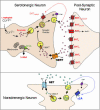Innovative approaches for the development of antidepressant drugs: current and future strategies
- PMID: 16489368
- PMCID: PMC1201318
- DOI: 10.1602/neurorx.2.4.590
Innovative approaches for the development of antidepressant drugs: current and future strategies
Abstract
Depression is a highly debilitating disorder that has been estimated to affect up to 21% of the world population. Despite the advances in the treatment of depression with selective serotonin reuptake inhibitors (SSRIs) and serotonin and norepinephrine reuptake inhibitors (SNRIs), there continue to be many unmet clinical needs with respect to both efficacy and side effects. These needs range from efficacy in treatment resistant patients, to improved onset, to reductions in side effects such as emesis or sexual dysfunction. To address these needs, there are numerous combination therapies and novel targets that have been identified that may demonstrate improvements in one or more areas. There is tremendous diversity in the types of targets and approaches being taken. At one end of a spectrum is combination therapies that maintain the benefits associated with SSRIs but attempt to either improve efficacy or reduce side effects by adding additional mechanisms (5-HT1A, 5-HT1B, 5-HT1D, 5-HT2C, alpha-2A). At the other end of the spectrum are more novel targets, such as neurotrophins (BDNF, IGF), based on recent findings that antidepressants induce neurogenesis. In between, there are many approaches that range from directly targeting serotonin receptors (5-HT2C, 5-HT6) to targeting the multiplicity of potential mechanisms associated with excitatory (glutamate, NMDA, mGluR2, mGluR5) or inhibitory amino acid systems (GABA) or peptidergic systems (neurokinin 1, corticotropin-releasing factor 1, melanin-concentrating hormone 1, V1b). The present review addresses the most exciting approaches and reviews the localization, neurochemical and behavioral data that provide the supporting rationale for each of these targets or target combinations.
Figures
Similar articles
-
Antidepressants: current strategies and future opportunities.Curr Pharm Des. 2010;16(38):4243-53. doi: 10.2174/138161210794519110. Curr Pharm Des. 2010. PMID: 21208177 Review.
-
Monoamine neurocircuitry in depression and strategies for new treatments.Prog Neuropsychopharmacol Biol Psychiatry. 2013 Aug 1;45:54-63. doi: 10.1016/j.pnpbp.2013.04.009. Epub 2013 Apr 19. Prog Neuropsychopharmacol Biol Psychiatry. 2013. PMID: 23602950 Review.
-
Differentiating antidepressants of the future: efficacy and safety.Pharmacol Ther. 2007 Jan;113(1):134-53. doi: 10.1016/j.pharmthera.2006.07.002. Epub 2006 Sep 27. Pharmacol Ther. 2007. PMID: 17010443 Review.
-
[Mechanism of action of antidepressants and therapeutic perspectives].Therapie. 2002 Jul-Aug;57(4):385-96. Therapie. 2002. PMID: 12422559 Review. French.
-
Current trends in the development of new antidepressants.Curr Med Chem. 2001 Feb;8(2):89-100. doi: 10.2174/0929867013373796. Curr Med Chem. 2001. PMID: 11172668 Review.
Cited by
-
Ophiocordyceps formosana improves hyperglycemia and depression-like behavior in an STZ-induced diabetic mouse model.BMC Complement Altern Med. 2016 Aug 24;16(1):310. doi: 10.1186/s12906-016-1278-7. BMC Complement Altern Med. 2016. PMID: 27553852 Free PMC article.
-
Contribution of GABA receptors to extinction of memory traces in normal conditions and in a depression-like state.Neurosci Behav Physiol. 2008 Oct;38(8):775-9. doi: 10.1007/s11055-008-9045-y. Epub 2008 Sep 18. Neurosci Behav Physiol. 2008. PMID: 18802774
-
Preclinical characterization of WAY-211612: a dual 5-HT uptake inhibitor and 5-HT (1A) receptor antagonist and potential novel antidepressant.Br J Pharmacol. 2009 May;157(2):307-19. doi: 10.1111/j.1476-5381.2009.00146.x. Epub 2009 Mar 26. Br J Pharmacol. 2009. PMID: 19338583 Free PMC article.
-
Antidepressant effects of ketamine and the roles of AMPA glutamate receptors and other mechanisms beyond NMDA receptor antagonism.J Psychiatry Neurosci. 2017 Jun;42(4):222-229. doi: 10.1503/jpn.160175. J Psychiatry Neurosci. 2017. PMID: 28234212 Free PMC article. Review.
-
Ameliorative effect of oregano (Origanum vulgare) versus silymarin in experimentally induced hepatic encephalopathy.Sci Rep. 2022 Oct 25;12(1):17854. doi: 10.1038/s41598-022-20412-3. Sci Rep. 2022. PMID: 36284120 Free PMC article.
References
-
- Eriksson E. Antidepressant drugs: does it matter if they inhibit the reuptake of noradrenaline or serotonin. Acta Psychiatr Scand 101 [Suppl 402]: 12–17, 2000. - PubMed
-
- Goodwin FK, Bunney WE Jr. Depressions following reserpine: a reevaluation. Semin Psychiatry 3: 435–448, 1971. - PubMed
-
- Clerc GE, Ruimy P, Verdeay-Pailles J. A double blind comparison of venlafaxine and fluoxetine in patients hospitalized for major depression and melancholia. Intl Clin Psychopharmacol 9: 138–143, 1995. - PubMed
-
- Guelfi JD, White C, Hackett D, Guichoux JY, Magni G. Effectiveness of venlafaxine in patients hospitalized for major depression and melancholia. J Clin Psychiatry 56: 450–458, 1995. - PubMed
-
- Benkert O, Grunder G, Wetzel H. Is there an advantage to venlafaxine in comparison with other antidepressants? Hum Psychopharmacol 12: 53–64, 1997.
Publication types
MeSH terms
Substances
LinkOut - more resources
Full Text Sources
Other Literature Sources
Medical
Molecular Biology Databases


